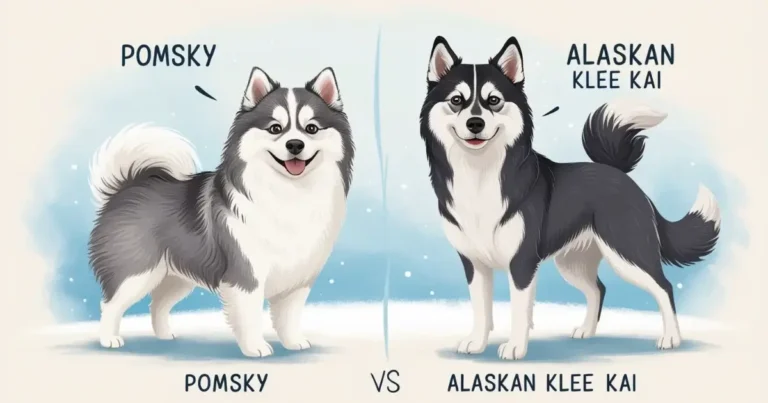Pomsky Growth Prediction: How to Know If a Pomsky Will Get Bigger?
Pomskies, a mix of Pomeranians and Siberian Huskies, are a popular breed. But many potential owners wonder, “How big will my Pomsky get?” Predicting their size is not simple because they are a crossbreed. Factors like genetics, parent size, and growth patterns play a role. Let’s explore Pomsky growth stages and how to estimate their final size.
Table of Contents
Pomsky Growth Stages and When They Stop Growing
Pomsky Growth Timeline
Pomskies grow quickly, especially during their first year. Here’s a breakdown of the major phases:
| Age | Growth Stage |
| 0-6 months | Rapid growth phase. Their legs grow longer, and their coat becomes fluffier |
| 6-12 months | Growth slows down, but their body fills out |
| 12-18 months | Final growth stage, with minor changes in weight |
Most Pomsky growth stages occur within the first year. Tracking these milestones helps in understanding your Pomsky’s development.
When Does a Pomsky Stop Growing?
Pomskies typically stop growing between 12-18 months. After their first birthday, their height and overall size stabilize. They might gain a little weight after this age, but major growth usually stops. So, if you’re wondering when does a Pomsky stop growing, it’s around 18 months.

Pomsky Size Prediction: What Affects Their Final Size?
Genetics and Breeding
Pomsky size prediction relies heavily on genetics. The size of the parents determines how big a Pomsky will get. For example:
- Pomeranians weigh around 3-7 pounds.
- Siberian Huskies can weigh up to 60 pounds.
Your Pomsky’s size will fall between these ranges. Genetics is always the deciding factor with crossbreeds. Some Pomskies take after their Pomeranian parent and stay small, while others resemble the Husky side and grow larger.
Generation and Size Variations
The generation of your Pomsky also affects its size:
- F1 Pomsky: Direct cross between a Pomeranian and a Siberian Husky. Size varies the most in this generation.
- F2 Pomsky: Bred from two F1 parents, with slightly more predictable sizes.
- F3 Pomsky: Shows the most consistency in size due to stable breeding practices.
Each Pomsky puppy is unique, so estimating size based on generation is just a guideline. Pomsky breed size variations are expected across different generations.
Understanding Pomsky Weight and Height Ranges
Pomsky Weight Chart and Height Expectations
Here’s an overview of typical Pomsky height and weight ranges:
| Size category | Weight | Height at Shoulder |
| Micro Pomsky | 10-15 pounds | 10-12 inches |
| Mini Pomsky | 15-25 pounds | 12-14 inches |
| Standard Pomsky | 25-30 pounds | 14-15 inches |
While most Pomskies weigh between 15-30 pounds and stand around 10-15 inches, size can vary based on which parent breed they take after. Each Pomsky is unique, so these are average ranges.
Size Categories: Micro, Mini, and Standard Pomskies
Pomskies come in three size categories:
- Micro Pomskies weigh 10-15 pounds.
- Mini Pomskies weigh 15-25 pounds.
- Standard Pomskies weigh 25-30 pounds.
So, how big do Pomskies get? Their size depends on which category they fall into, but expect them to fall within these ranges.

How to Track and Predict Your Pomsky Growth
Growth Rate Tracking
To estimate your Pomsky’s size, track their Pomsky puppy growth rate. Weigh and measure them regularly during their first year, especially in the first six months when most growth happens. Signs your Pomsky is growing include weight gain, a longer body, and a fuller coat. By 12 months, growth slows down.
Using a Pomsky Size Calculator
For a rough prediction of your Pomsky’s final size, use a Pomsky size calculator. These tools estimate their adult size based on current weight and age. While not 100% accurate, they give a good estimate by considering Pomsky growth factors like genetics and growth patterns.
What Factors Influence Pomsky Size and Growth?
Nutrition and Diet
A proper diet is essential for Pomsky puppy development. High-quality, nutrient-rich food ensures healthy growth. Adequate protein, vitamins, and minerals support your Pomsky’s overall development. What affects Pomsky size most in terms of diet is making sure they’re getting the right nutrients, especially during their early months.
Exercise and Activity Levels
Exercise also influences Pomsky growth factors. Regular activity helps build strong muscles and bones. However, too much exercise can stress their joints while they’re still growing. A balanced routine of play and rest is key.
What to Expect from an Adult Pomsky
Average Pomsky Adult Size
When fully grown, most Pomskies weigh between 15-30 pounds. This range depends on their parents’ size. While each dog is unique, the average Pomsky adult size falls within this spectrum.
Body Proportions and Coat Changes
As they mature, Pomskies may experience changes in body proportions and their coat. Their fluffy, double coat will likely thicken and may change color over time. These changes are a normal part of how big does a Pomsky grow as they transition into adulthood.
Conclusion: Can You Know How Big Your Pomsky Will Get?
Predicting a Pomsky’s size is based on genetics, growth tracking, and some uncertainty. Tools like a Pomsky size calculator or Pomsky weight charts can help estimate size, but each Pomsky is unique. Regardless of size, they’re full of charm and personality!
FAQs
How can I use a Pomsky size calculator effectively?
A Pomsky size calculator estimates your dog’s adult size by inputting their current weight and age. It considers factors like genetics and growth patterns, providing a good estimate of how big your Pomsky will grow.
When do Pomskies stop growing, and what should I expect?
Most Pomskies stop growing between 12-18 months. After this, they may gain a little weight, but their height and overall size usually stabilize, resulting in an average Pomsky adult size of 15-30 pounds.
How does nutrition affect Pomsky puppy development?
Proper nutrition is crucial for Pomsky puppy development. A balanced diet rich in protein, vitamins, and minerals supports healthy growth and influences what affects Pomsky size. Monitor portion control to ensure optimal growth.
What are the signs your Pomsky is growing?
Signs your Pomsky is growing include noticeable weight gain, lengthening body, and a fuller coat. Tracking these indicators can help you gauge their Pomsky puppy growth rate and overall health.







